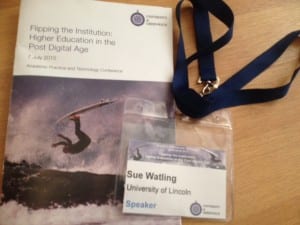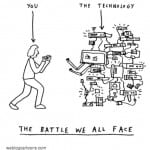 I left Greenwich reinspired. Conferences do this to you. Fill your head with new ways of thinking and seeing the world. You’re enthused and want to capture and share the experience. I left with ideas about how to be more creative, make greater use of multimedia, re-engage with Twitter, turn blog posts into videos, recreate TELEDA as a MOOC, then went back to work and was reminded of the divide between thought and practice. Developing digital capabilities and competencies takes time and there is never enough. The early rhetorical promises of educational technologies to cut costs and increase efficiency missed completely the need to learn and polish new ways of working.
I left Greenwich reinspired. Conferences do this to you. Fill your head with new ways of thinking and seeing the world. You’re enthused and want to capture and share the experience. I left with ideas about how to be more creative, make greater use of multimedia, re-engage with Twitter, turn blog posts into videos, recreate TELEDA as a MOOC, then went back to work and was reminded of the divide between thought and practice. Developing digital capabilities and competencies takes time and there is never enough. The early rhetorical promises of educational technologies to cut costs and increase efficiency missed completely the need to learn and polish new ways of working.
The 13th Academic Practice and Technology Conference was at the University of Greenwich on 7th July. The location was unique – the only university to be on a National Heritage site – The Old Royal Naval College – built by Christopher Wren on the side of the River Thames and next to the Cutty Sark, now encased in an ugly glass visitor surround and box.
The naval college consists of four courts. The famous Painted Hall in King William Court was closed to visitors because Kiera Knightly and Joan Collins were filming so I stood under an open window in neighbouring King Charles Court, home of the Trinity Laban School of Music and Dance, and listened to Mussorgsky’s Pictures from an Exhibition played on a solo piano instead. It was magical.
The conference was in Queen Anne Court. Titled Flipping the Institution: Higher Education in the Post-Digital Age, the welcome text included reference to not all students being comfortable or sufficiently skilled to engage in post digital environments. I was there to say the same about academics and how the subject of staff digital confidence has become a case of elephants (in the room) and emperors (new clothes). We don’t talk about it but we should. I presented some themes from my literature review and data analysis:
- The focus of the educational technology literature is on the student as elearner rather than academics as eteachers – yet eteaching is the corollary to elearning.
- The literature of elearning is predominantly about success stories – yet we know there’s more to be learned from studying failure
- The experience of those who are not great technology advocates is missing – resistance and reluctance are not being explored
- Making assumptions about digital ways of working is risky and may lead to failure The diversity of different starting points is rarely recognised
- Digital literacies are complex – they mirror us as individuals, everyone approaches virtual environments in different ways, so models and frameworks need to be flexible to accommodate diversity (and start from zero)
- Academics need time and space to become e-teachers and engage with digital pedagogies as well as gain digital confidence – not good news when everyone is squeezed and stretched but staff development has to protected in particular when it comes digital ways of working
- Everyone wants students to have the best possible experience – but not everyone sees technology as a way of achieving this
- It would help to shift from training models of competency to teacher education programmes; TELEDA shows the value of an approach which is structured around experiential learning and critical reflection and TELEDITEs take their TELEDA experience into their practice.
One of the outputs from the three years of TELEDA development has been what I call the Myths of Digital Competence. They go something like this:
- Not everyone owns a mobile device or has access to an up to date computer off campus.
- Not everyone realises apps like BB mobile don’t give full functionality
- Common technical support advice is to use another browser but not everyone knows what browser they’re using or how to change to a different one
- Not everyone can get photos off their camera or phone onto a computer
- Not everyone can use a text editor or turn text into a URL
- html view is useful for tweaking, trouble shooting or getting the embed code from YouTube but not everyone knows you can do this or how to do it
- The majority of academics don’t have access to a webcam or microphone – or a quiet place to record a narration
More about the presentations by Jonathan Worth, Robert White and Helen Beetham in elearning, eteaching, eliteracies part two.











